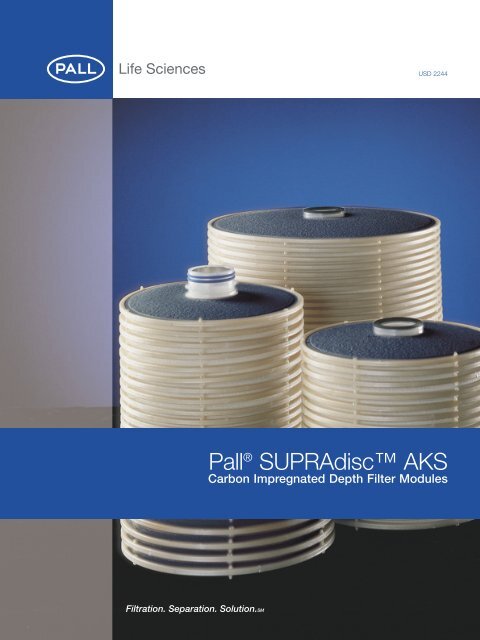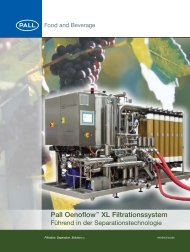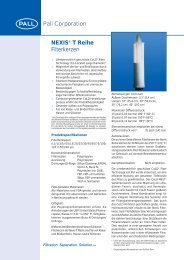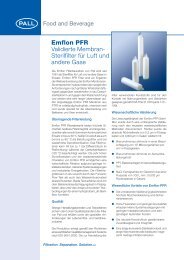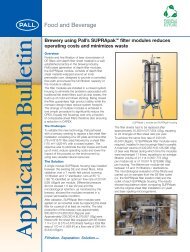USD 2159 AVL - Filtra
USD 2159 AVL - Filtra
USD 2159 AVL - Filtra
Create successful ePaper yourself
Turn your PDF publications into a flip-book with our unique Google optimized e-Paper software.
<strong>USD</strong> 2244<br />
Pall ® SUPRAdisc AKS<br />
Carbon Impregnated Depth Filter Modules
SUPRAdisc AKS<br />
Carbon Impregnated Depth Filter Modules<br />
Activated carbon is an inert microporous material derived from raw material such<br />
as peat, wood, coconut, lignite or coal. Activated carbon is characterized by<br />
millions of pores of molecular dimensions creating a large and highly adsorptive internal<br />
surface area up to 2,000 m 2 per gram.<br />
Activated carbon is often used for<br />
purification and decolorization of<br />
pharmaceutical and chemical products and<br />
of foodstuffs. The substances responsible<br />
for the color are removed by adsorption<br />
unlike in bleaching processes, where the<br />
substances are converted. As a function<br />
of the concentration of the material to be<br />
adsorbed, an equilibrium forms between<br />
the phases (liquid or gas) and the surface<br />
of the activated carbon. A further<br />
characteristic feature of activated carbon<br />
is the practically non-polar surface resulting<br />
in a high affinity to the likewise mostly nonpolar<br />
organic molecules. (For further<br />
information see “Adsorption”)<br />
Advantages of the SUPRAdisc AKS<br />
Modules<br />
• No separation of activated carbon<br />
necessary<br />
• Dust-free processes<br />
• Quick and easy module change<br />
• In-line sterilization<br />
• No channel formatting e.g. with<br />
activated carbon columns<br />
• Enclosed systems in accordance with<br />
GMP<br />
• Highly reliable due to patented central<br />
core adapter system<br />
• Very low hold-up volume<br />
• Easily scaleable due to modular design<br />
Versions<br />
SUPRAdisc AKS depth filter modules are<br />
available in three versions for different<br />
applications:<br />
AKS 6<br />
Applications in the pharmaceutical industry<br />
as well as biotechnology, blood and<br />
chemical industry<br />
AKS 5<br />
Applications in the pharmaceutical and<br />
biotechnology sector<br />
AKS 4<br />
Applications in the API market
AKS 6<br />
General Characteristics<br />
AKS 6 depth filters contain a special porous<br />
carbon in powdered form, which is mainly<br />
responsible for successful adsorption<br />
processes in many liquid phase<br />
applications. Its typical pore size distribution<br />
(ratio of micropores, mesopores and<br />
macropores) and relatively low<br />
hydrophobicity allows easy access for high<br />
molecular weight molecules and additionally<br />
specific adsorption of materials with a<br />
molecular weight between 1 and 100 kDa<br />
(e.g. natural colorants, humic substances,<br />
biopolymers like PKA)*. With AKS 6 depth<br />
filters, protein solutions (e.g. plasma<br />
products like albumin) can be purified by<br />
selective adsorption of PKA, because the<br />
loss of target proteins is very small. The<br />
more non-specific removal capabilities of<br />
other organic impurities such as natural<br />
colorants from protein solutions is<br />
preserved.<br />
The low iron and aluminium content of the<br />
activated carbon in the AKS 6 depth filters<br />
makes it particularly suitable for applications<br />
such as pharmaceutical and biotechnological<br />
processes.<br />
PKA adsorption (%)<br />
90<br />
80<br />
70<br />
60<br />
50<br />
40<br />
30<br />
20<br />
10<br />
0<br />
Competitor<br />
AKS 6<br />
1 2 3 4<br />
Different PKA adsorption conditions<br />
Endotoxin Content<br />
AKS 6 contains < 0.02 EU/mL after 50 L/m 2<br />
flushing with WFI (AKS 6 doesn’t contain<br />
LAL inhibiting or enhancing substances)<br />
Biological Safety<br />
Certificates by NAMSA are available upon<br />
request.<br />
PKA Reduction<br />
During plasma processing different<br />
important pharmaceutical proteins are<br />
isolated and purified under very specific<br />
conditions, to avoid activation of the blood<br />
coagulation system in plasma. The<br />
production conditions have a strong<br />
influence on the activation of the very<br />
complex coagulation sequence. This may<br />
lead to pharmaceutically very potent<br />
metabolic products, responsible for<br />
inflammation and hypotension syndromes<br />
in patients, who are treated with these byproducts.<br />
Figure 1 Figure 2<br />
PKA adsorption (%)<br />
SUPRAdisc AKS<br />
Carbon Impregnated Depth Filter Modules<br />
(Activation of the blood coagulation system<br />
in vivo is essential and mainly responsible<br />
for healing of wounds performed by very<br />
complex biochemical reactions in blood).<br />
Precise control of the entire production<br />
process is therefore essential during plasma<br />
fractionation.<br />
* (PKA (prekallikrein-activator) is one of the central<br />
metabolic products and is an indicator of the quality of<br />
the plasma production process).<br />
Results of PKA Testing<br />
In several investigations the AKS 6 depth<br />
filter shows distinct advantages in the PKA<br />
reduction compared to competitor products.<br />
(see Figure 1). The adsorption curve<br />
(Figure 2) additionally demonstrates a good<br />
performance of the AKS 6 depth filter in PKA<br />
reduction.<br />
Taking the PKA adsorption into account, the<br />
superiority of the AKS 6 depth filter is even<br />
more significant. The advantages compared<br />
to the competition is evident. The PKA<br />
clearance is a very important application<br />
parameter, which combines the potential of<br />
PKA reduction in human albumin solutions<br />
and selectivity of the adsorption process.<br />
100<br />
90<br />
80<br />
70<br />
60<br />
50<br />
40<br />
30<br />
20<br />
10<br />
0<br />
500 1000 1500 2000 2500 3000 3500 4000<br />
PKA amount (IU/m2 Competitor<br />
AKS 6<br />
x 1000)
SUPRAdisc AKS<br />
Carbon Impregnated Depth Filter Modules<br />
AKS 5<br />
General Characteristics<br />
The SUPRAdisc AKS 5 depth filter modules<br />
has been specially developed for the<br />
requirements of the pharmaceutical industry<br />
(e.g. for decolorization of blood products,<br />
glucose, solutions and antibiotics). The<br />
carbon used in the AKS 5 meets the<br />
requirements of the European and US<br />
Pharmacopeia.<br />
Applications<br />
For decolorization of blood products such<br />
as albumin, SUPRAdisc AKS 5 can be<br />
successfully applied during the Cohn<br />
fractionation process and also for the<br />
removal or reduction of<br />
• Hemoglobin traces<br />
• Biliverdin traces<br />
• Lipids<br />
• Anticoagulants<br />
• Detergents<br />
In addition SUPRAdisc AKS 5 depth<br />
filter modules are used for the filtration<br />
of products such as<br />
• Antibiotics<br />
• Glucose solutions<br />
• Enzymes<br />
• Vitamins<br />
The recommended flow velocities for<br />
decolorization of albumin and other<br />
pharmaceutical products is 100 -<br />
200 L/m2h, for decolorization and<br />
deodorizing of sugar solutions 350 -<br />
400 L/m2h and for dechlorination of<br />
water 50 - 150 L/m2h. Diagram of Albumin Production<br />
Including Adsorption Step with<br />
SUPRAdisc AKS 5<br />
Separation Fraction I<br />
Fibrinogen<br />
▼<br />
Separation Fraction II/III Immunoglobuline<br />
▼<br />
Fraction V Albumin<br />
▼<br />
Removal of pastes and precipitates SUPRAdur ®<br />
50 P support sheets<br />
▼<br />
<strong>Filtra</strong>tion SUPRAdisc BIO 10<br />
or BIO 20 modules<br />
▼<br />
Adsorption/Decolorization, SUPRAdisc AKS 5<br />
PKA removal SUPRAdisc AKS 6<br />
▼<br />
Dialyze<br />
▼<br />
Ultrafiltration<br />
▼<br />
Sterile <strong>Filtra</strong>tion<br />
▼<br />
Filling
AKS 5<br />
Adsorption capacity<br />
The outstanding feature of the<br />
pharmacopeiaen-grade activated carbon<br />
used for depth filter modules is the very<br />
high adsorption capacity due to the special<br />
pore structure and the unusually high<br />
degree of activation of the carbon. This<br />
way the pharmacopeial requirements are<br />
not only met but even surpassed. ( The<br />
main criteria for pharmacopeian – grade<br />
activated carbon is the adsorption capacity<br />
of methylene blue).<br />
If suspended, colloidal or emulsified<br />
particles are removed prior to filtration, the<br />
adsorption capacity of the SUPRAdisc<br />
AKS 5 modules can be increased even<br />
further, this can be carried out with Pall<br />
prefilter systems prior to the adsorption<br />
process step.<br />
Extractables<br />
SUPRAdisc modules contain very low<br />
amounts of extractables such as aluminum,<br />
iron etc. For further details, please contact<br />
Pall.<br />
Endotoxin content<br />
AKS 5 contains < 0.02 EU/mL after 50 L/m 2<br />
flushing with WFI (AKS 5 doesn’t contain<br />
LAL inhibiting or enhancing substances)<br />
Advantages of the SUPRAdisc SD<br />
AKS5 Filter Modules<br />
Economy<br />
• Very economical due to high<br />
adsorption capacity<br />
• Low protein adsorption<br />
Quality<br />
• Very high purity (meets the USP/EUR<br />
requirements)<br />
• Very low content of extractables, e.g.<br />
aluminium irons and endotoxins<br />
• Very low pH-shift<br />
SUPRAdisc AKS<br />
Carbon Impregnated Depth Filter Modules
SUPRAdisc AKS<br />
Carbon Impregnated Depth Filter Modules<br />
AKS 4<br />
Application for the API and<br />
Foodstuff Industry<br />
The filter modules containing activated<br />
carbon (SUPRAdisc AKS 4) have been<br />
specially developed for the requirements in<br />
the chemical and foodstuff industries. Due<br />
the excellent adsorption capacity, the<br />
SUPRAdisc AKS 4 modules have proven<br />
successful in the following applications:<br />
• Decolorization of chemicals and plant<br />
extracts<br />
• Dechlorination of water<br />
• Decolorization of silicon oils<br />
Total Throughput of Chlorinated Water in m 3 /m 2 until Cl 2 breakthrough at specific flow<br />
Velocities using AKS 4<br />
Initial 250 500 750 1000<br />
Concentration L/m -2 h -1 L/m -2 h -1 L/m -2 h -1 L/m -2 h -1<br />
mg Cl 2 /L<br />
* Calculated values<br />
100 2.2 1.9 1.6 1.2<br />
10 23 19 14 8<br />
1 130* 100* 85 60*<br />
Application Summary of the Different AKS Types<br />
AKS 4 AKS 5 AKS 6<br />
Proteins + ++ +++<br />
Dark colorants + ++ +++<br />
Medium colorants + ++ ++<br />
Natural pigments + ++ ++<br />
Pyrogens 0 +++ +<br />
Light colorants 0 +++ +<br />
Color precursors + +++ +<br />
Odor compounds + +++ +
Parameters Affecting the Adsorption<br />
<strong>Filtra</strong>tion Velocity<br />
The available contact time is of significant<br />
importance in adsorption processes. Using<br />
SUPRAdisc AKS depth filter modules the<br />
contact time can be varied by suitable<br />
adjustment of the filtration velocity. Low<br />
filtration velocities, resulting in long contact<br />
times have a positive effect on the<br />
adsorption capacity (Figure 3).<br />
Temperature<br />
The diffusion rate increases at higher<br />
temperatures. Thus adjustment of the<br />
adsorption equilibrium is obtained more<br />
rapidly. However, the total amount of<br />
adsorbable substances is higher at lower<br />
temperatures (Figure 4). Hence, in most<br />
cases a higher adsorptive capacity is<br />
yielded at lower temperature provided that<br />
the contact time is long enough for the<br />
product in question. This basic statement,<br />
however, is only applicable if the substance<br />
to be adsorbed shows uniform structures<br />
at varying temperatures. If the structure<br />
changes, the temperature may have a<br />
reverse effect.<br />
pH-Value<br />
Depending on the activated carbon and on<br />
the different isoelectric points of the<br />
substances to be adsorbed, the adsorption<br />
capacities can vary considerably at different<br />
pH- values (Figure 5). However, particularly<br />
in regard to the pH-value, interactions<br />
between different product substances<br />
and/or the structure of a component are<br />
possible. Therefore, no general statement<br />
can be made about the adsorption as a<br />
function of the pH-value.<br />
Figure 3<br />
Methylene adsorption g/m 2<br />
250<br />
240<br />
230<br />
220<br />
210<br />
200<br />
Figure 4<br />
Methylene adsorption in mg g -1<br />
Comparison of the Methylene Blue Adsorption by<br />
SUPRAdisc AKS 5 at Different <strong>Filtra</strong>tion Velocities<br />
SUPRAdisc AKS<br />
Carbon Impregnated Depth Filter Modules<br />
190<br />
0 250 500 750 1000 1250 1500 1750 2000<br />
<strong>Filtra</strong>tion velocity in L/m -2 h -1<br />
540<br />
520<br />
500<br />
480<br />
460<br />
Figure 5<br />
Methylene adsorption in mg g -1<br />
Comparison of the Methylene Blue Adsorption by<br />
SUPRAdisc AKS 5 at Different <strong>Filtra</strong>tion Temperatures<br />
440<br />
0 10 20 30 40 50 60<br />
Temperature in °C<br />
1000<br />
900<br />
800<br />
700<br />
600<br />
Comparison of the Methylene Blue Adsorption by<br />
SUPRAdisc AKS 5 at Different pH Values<br />
500<br />
4 5 6 7 8 9 10 11<br />
pH - value
SUPRAdisc AKS<br />
Technical Specifications<br />
Operating Characteristics*<br />
Maximum Operating 80°C (176°F) in Polypropylene design<br />
Temperature 160°C (320°F) in Polyamide design<br />
Maximum Operating Pressure 2.4 bard (35 psid)<br />
* With compatible fluids, which do not soften, swell or adversely affect the products<br />
or its material of construction.<br />
3<br />
Plastic Parts of Construction of SUPRAdisc Modules<br />
SUPRAdisc Components Polypropylene (Standard version)<br />
Polyamide (High temperature version)<br />
O-rings Silicone elastomer<br />
Filter Media Configurations<br />
Code Filter<br />
Type<br />
See Above Table<br />
New York - USA<br />
+1 516 484 5400 phone<br />
+1 516 801 9548 fax<br />
pharmafilter@pall.com e-mail<br />
Portsmouth - Europe<br />
+44 (0)23 9230 3303 phone<br />
+44 (0)23 9230 2506 fax<br />
BioPharmUK@europe.pall.com e-mail<br />
Sterilization<br />
Steam in Place 125°C (257°F) for 30 minutes<br />
at 0.3 bard (4.3 psid) maximum.<br />
Nominal Dimensions<br />
Nominal Total Length<br />
Double O-ring 332 mm (13.1 in)<br />
Flat Gasket 272 mm (10.7 in)<br />
Nominal Diameter 284 mm (11.2 in) (1)<br />
(1) Filter area codes 205, 209, 214 and 215.<br />
(2) Filter area code 416 only.<br />
Code Gasket<br />
Material<br />
410 mm (16.1 in) (2)<br />
Code Depth Filter Mass per Unit Ash Content Extractable Ions Soluble in Acetic Acid<br />
(For Part Number Structure)<br />
Type Area (g/m 2 ) in % (5%) (mg/m 2 )<br />
Part Numbering and Ordering Information<br />
Code Module<br />
Version<br />
00 Standard<br />
01 High<br />
temperature<br />
30 Increased<br />
cell<br />
distance<br />
Code Adapter<br />
S Double<br />
O-ring<br />
C Flat<br />
Gasket<br />
Code Filter<br />
Area<br />
205 0.5 m 2 (5.4 ft 2 )*<br />
209 1.0 m 2 (10.7 ft 2 )<br />
214 1.5 m 2 (16.1 ft 2 )**<br />
215 1.7 m 2 (18.2 ft 2 )***<br />
416 3.7 m 2 (39.8 ft 2 )<br />
* Only available with double<br />
O-ring.<br />
** Only AKS 5 and AKS 6<br />
*** Only AKS4<br />
Ca Fe Al<br />
XAK4 AKS 4 1050 13 2000 100 100<br />
XAK5 AKS 5 1400 < 1 550 20 15<br />
XAK6 AKS 6 1400 < 1 1000 25 10<br />
S Silicone<br />
elastomer<br />
Other gaskets available on<br />
request<br />
Code Plastic Parts<br />
P Polypropylene<br />
A Polyamide (2)<br />
(2) High Temperature only.<br />
Visit us on the web at www.pall.com/biopharmaceutical<br />
Pall Corporation has offices and plants throughout the world in locations including:<br />
Argentina, Australia, Austria, Belgium, Brazil, Canada, China, France, Germany, India,<br />
Indonesia, Ireland, Italy, Japan, Korea, Malaysia, Mexico, the Netherlands,<br />
New Zealand, Norway, Poland, Puerto Rico, Russia, Singapore, South Africa, Spain,<br />
Sweden, Switzerland, Taiwan, Thailand, United Kingdom, the United States and Venezuela.<br />
Distributors are located in all major industrial areas of the world.<br />
Because of developments in technology these data or procedures may be subject to change. Consequently we advise<br />
users to review their continuing validity annually.<br />
, Pall, SUPRAdisc and SUPRAdur are trade marks of Pall Corporation.<br />
<strong>Filtra</strong>tion. Separation. Solution. is a service mark of Pall Corporation.<br />
Part Numbers quoted above are protected by the Copyright of Pall Europe Limited.<br />
® indicates a trademark registered in the USA.<br />
© 2004, Pall Europe Limited.<br />
10.2004


